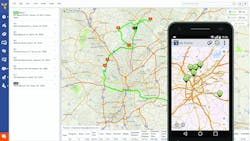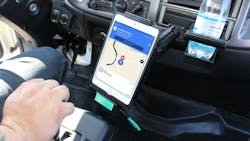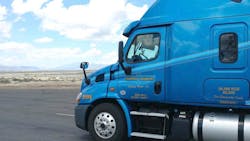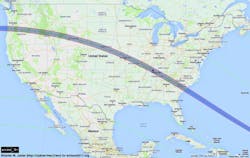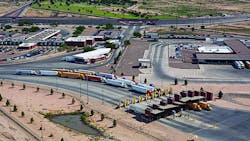Just being able to tell a truck driver how to get from point A to point B is no longer good enough. With growing demands from shippers and hours-of-service (HOS) limitations, there is a need for real-time navigation to ensure drivers' routes are optimized, and that they have an accurate picture on when and where to stop.
Software developers are making strides in determining how weather events will affect highway congestion, though fleet executives said better integration of individual systems is still required.
Real-time routing "isn't just about traffic," when factoring in HOS and road restrictions, said Marleen Winer, a vice president with TeleType Co., makers of the SmartTruck routing app. They need to know if "pulling over now is more beneficial than sticking it out for 15 minutes."
To provide a real benefit, truckers need to get the information before they get too close to an incident, as side roads can quickly back up, said John McAvoy, vice president of GIS engineering for Rand McNally.
"They need to get a route-around when they still have a chance to truly get around the whole area," he said.
The need extends beyond the immediate road ahead, noted Kelly Frey, vice president of product marketing for Telogis, which was acquired by Verizon last year.
New technology allows drivers to get updates from shippers and receivers, potentially leading them to consider taking an earlier break, adjusting off-duty planning, or even making another local pickup.
"We are now in the era of big data and hosted cloud applications," Frey said. With many of today's telematics systems, "we are able to tackle these really big optimization problems."
That was the case earlier this year after a bridge on Interstate 85 in Atlanta collapsed. During the 44-day detour, the result was millions of dollars of economic damage, but better routing helped truckers avoid even greater losses, he said.
Big data allows for the optimization of a route with many stops within seconds, said George Shchegolev, co-founder and vice president of operations of Route4Me.
Besides determining the best order for deliveries, Route4Me factors in daily weather events that would likely slow overall conditions, and alter estimated arrival times.
"You can't necessarily expect a guy to make 15 stops on a sunny day and 15 stops on a rainy day in the same time," he said.
Route4Me continuously optimizes a route and can automatically make changes for drivers, if requested, as well as send updated notifications to waiting customers.
Faster route automation provides another advantage, Shchegolev pointed out. Carriers can accept additional deliveries later into the evening than in the past, and still have an optimized route ready to go the next morning because it can be processed so quickly.
Besides advanced technology, more companies are using truckers' own first-hand experiences to improve overall routing. SmartTruck, for example, relies on user feedback not only on traffic, but also for situations when a trucker comes upon a particularly narrow turn and recommends going forward several blocks instead.
"We do not simply take a report and post it," said Winer. "We do vet it because for commercial drivers, this is serious. You have to make sure it isn't a mistake."
That could include contacting local police or checking satellite images for confirmation, she noted.
SmartTruck, which started as a handheld device about 10 years ago, is now a subscription-based smartphone app. When there is a serious traffic event, it can send a push notification. Drivers can touch the map to avoid an area and receive back an alternative truck-specific route option.
Overall, John Benusa, CIO of Transport America, told Fleet Owner that "as an industry, we have a long way to go, but there is no doubt we've made a lot of progress" on real-time navigation.
One particular shortfall, he said, has been the ability to prepare ahead of time for bad weather. After the particularly rough winter of 2013-14, the Eagan, MN, based truckload carrier concluded that "it had to do something different to better navigate efficiently and safely."
After not finding the right product on the market, Transport America partnered with ALK Technologies to develop a customized system to determine what trucks were heading into a winter weather alert area as well as what loads not yet dispatched could be affected by a developing system.
The main goal, Benusa said, was to alert drivers and let them make the best decision about staying safe, whether that meant rerouting or stopping.
"We reiterated through this process [that drivers] are in charge," Benusa said. "If it's getting unsafe, it's okay to shut down."
The early weather notifications allow drivers to seek out spaces at truck stops before they fill up. "They know ahead of time where they can seek safe haven and not get stranded on the side of the road," he said.
In the year prior to implementing the system, Transport America had 19 reportable accidents related to weather compared with only two just two years later. While he acknowledged it is "impossible to compare" one winter season with another, this clearly shows "a great reduction."
Drivers also found themselves getting stuck in far fewer extended and potentially dangerous highway shutdowns.
In May, the Weather Co., a unit of IBM, entered the commercial vehicle space to help trucking companies be more aware of major weather disturbances and danger from more localized problems such as fog or ponding on road surfaces, said John Bosse, offering manager for ground transportation.
The company wants to provide "better situational awareness of what is happening on the roadways," he said.
Fleets can tailor alerts, such as sending an audible text message with detailed instructions to a driver when winds top 40 mph.
"There is so much great technology, but at the same time we have a group of users that need to be focused on the road and not on technology," Bosse said.
Riskpulse, another firm in this space, uses near-term forecasts and historical data to advise clients on when to ship products early or when to consider delays due to anything from winter storms to severe heat waves that could cause roads to buckle.
Jon Davis, meteorology team lead, told Fleet Owner the company wants the entire transportation supply chain "to break out of the business-as-usual philosophy."
He said Riskpulse looks at individual products moving on specific lanes. When conditions are right, fleets could safely transport ice cream in a dry van rather than a reefer unit, offering significant fuel savings.
"We are getting better and better at the specifics, looking at what exact temperature impacts products," he said.
Likewise, Riskpulse works with food and beverage companies to avoid freezing and spoilage ahead of polar air masses during winter months. For a trucker, the advice could be very different if beer versus mayonnaise was being transported.
Rand McNally's McAvoy also touted the use of historical data, noting that knowledge of roads that are more susceptible to icing can be leveraged to proactively reroute truckers to alternatives before a problem ever develops.
Despite these positive strides, Transport America's Benusa warned there remains a fundamental problem—weather, parking and other information does not tie into existing in-cab navigation systems.
"It is still difficult to get to drivers in the cab and give him the information he needs on a real-time basis to pull over to a truck stop or to reroute. Those things are not yet mature enough to allow a Class 8 truck . . . to make a decision in the cab without having to pull in multiple devices. That part of real-time routing is still where we have that gap."
The need for better integration is of great concern to Mike Card, president of Combined Transport in Central Point, OR. "There is a huge potential... to have trucks be able to tell drivers where to park and where to fuel," he explained.
Card emphasized the strain created by the shortage of safe truck parking. To help overcome the problem, Combined Transport's drivers use the Trucker Path app, but Card said parking information is generally not yet timely and accurate enough across the United States.
The situation is so critical, Card noted, many truckers seek out general points of interest rather than truck stops. There tends to be available parking at those locations, although no fuel or food options. Besides Trucker Path, Combined Transport uses a separate system to monitor fuel prices as well as onboard communication devices that include navigation.
While drivers are instructed to take the shortest possible route to their destinations, that can be frustrating for a driver who simply wants to know "how to get the most stuff done," Card concluded.
Rand McNally's McAvoy said he views the electronic logging mandate as a catalyst for further innovations in real-time routing. By electronically preventing drivers from extending their hours beyond legal limits, he said it puts more pressure on navigation and technology companies to deliver advanced ways to reach their destination—whether a drop-off location or an available parking space.
Rare total solar eclipse could create traffic
The event is the first total solar eclipse to reach the continental United States since 1979. As the moon passes between the Sun and Earth, all sunlight is briefly blocked, turning day into darkness. It will reach the Oregon coast at about 10:15 a.m. local time, rapidly moving across 14 states in under two hours.
In June, the Oregon Dept. of Transportation issued a special alert to truckers, warning that one million visitors will be flooding the state.
"Besides bracing for heavy traffic, [the Oregon Office of Emergency Management] also suggests preparing for possible cell phone service disruptions due to the increase in visitors," the alert said.
In its effort to assist, Oregon said commercial drivers seeking a safe location to park will be allowed to access weigh stations. The state is also recommending carriers talk to suppliers to change delivery schedules, especially along the rural roads projected to be the most clogged.
In explaining what truckers in the path of the eclipse might expect, Kelly Frey, vice president of product marketing for Telogis, used Pope Francis's visit to the United States in 2015 as an example. After getting information of his schedule and related road closings, it was plugged into the Telogis's algorithm.
For many truckers, that meant simply being aware there would be additional congestion. For others, the advice was avoiding certain areas completely at specific times.
"Customers are expecting us to be out ahead of events," Frey said. "There are real dollars at stake when they are sitting stuck on the road in congestion."
Jon Davis, Riskpulse meteorology team lead, took note of the eclipse in the summer of 2016, when a customer in the Netherlands sought his advice on the best place to view the eclipse (Risk Pulse's data determined it is Wyoming).
Davis said the eclipse is a good example of an event that creates "a totally unique" traffic configuration. He suggested while those in direct path should expect to see significantly more traffic, other areas may be likely to benefit from fewer vehicles on those roads.
Back in Oregon, Mike Card, president of Combined Transport in Central Point, expressed skepticism about how bad the traffic mess will be. But Card said it is important truck drivers are notified about the event, especially when it comes to safety. "Watch out for idiots pulling off the road right in front of you," he stressed.
Marleen Winer, a vice president with TeleType Co., makers of the SmartTruck routing app, said her company will likely warn customers days ahead of time. For something as rare as a total solar eclipse, alerting drivers to the odd change in light and potential dangerous windshield glare may be even more important than the traffic, she suggested.
App eases border congestion
The city of El Paso, TX, has jumped into the real-time navigation arena, launching a website and smart phone app in May to share information on the six local U.S.-Mexico border crossings.
The "Metropia" app provides wait time and other information for commercial vehicles, passenger vehicles and pedestrians.
"This innovative program . . . gathers real time information from commuters who are crossing the border 24 hours a day," said Mathew McElroy, director of El Paso's International Bridges Dept.
Besides reducing wait times and cutting air pollution, El Paso is hopeful the data obtained through use of the technology will help better develop policy and infrastructure investment decisions in the future.
About the Author
Neil Abt
Neil Abt is a former FleetOwner editor who wrote for the publication from 2017 to 2020. He was editorial director from 2018 to 2020.
